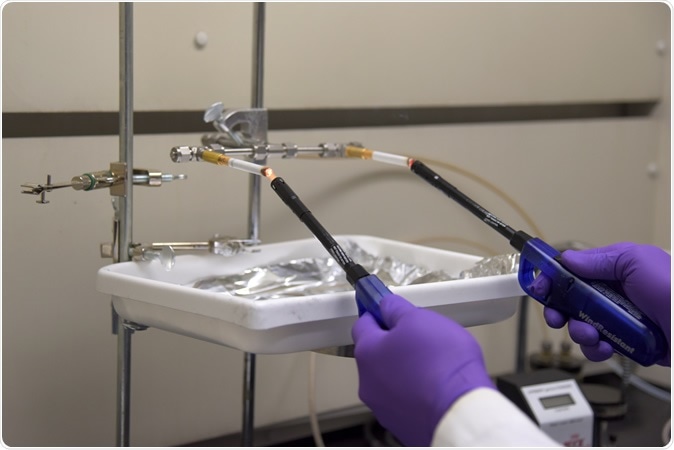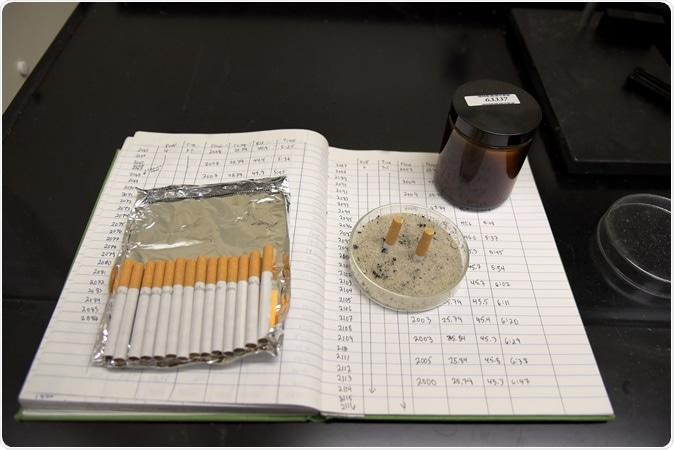A new study says cigarette butts continue to emit toxic fumes for days after they’ve been extinguished.
There are more than 5 trillion (that’s 5 thousand billion, or 5 million million or, 5,000,000,000,000) cigarette butts littering the world. These cause dust and dirt to pile up, clutter public places, and may have an adverse influence on ground water and wildlife. But little thought has gone into whether they also pollute the air.

Image Credit: NIST
The background
Smoking escaped scrutiny for decades because of the same absence of information and awareness of the emissions from burning cigarettes, pipes and cigars. This lack of measurement led to huge amounts of polluted air entering the human lungs and the lungs of animals. Once this was recognized following 50 years of measuring emissions from smoking cigarettes, epidemiological studies were launched to help understand how these emissions affect the human organisms.
Mainstream and sidestream smoke
Much data has since poured in about how smoking affects the lungs and other parts of the body, both during inhalation of smoke and exhalation. Other than mainstream smoking, which is what smokers are exposed to, the health impact of second-hand smoke has also been studied. This includes smoke from burning tobacco as well as the smoke exhaled by smokers.
It is only in recent years that a new term, called thirdhand smoke, has come into use. This refers to the residue of smoke that clings to surfaces like walls and furnishings, both soft and hard, as well as to toys and clothes, even when no one is smoking.
All three categories of smoking have been found to promote the risk of cancers and many other health problems. The risk is especially high in infants and children because their bodies are still developing, and this leaves the immature cells more prone to the effects of the toxins in cigarette smoke.
Filters came into use in the 1950s, being advertised as a means of detoxifying cigarettes. It is true that some of the tar, or black residue, from smoking cigarettes, is collected on the filter, it doesn’t do much to prevent damage to the body from the emissions. On the other hand, filters do act as a cigarette handle, making it easier to handle the device when it’s burning, and avoiding tobacco staining of fingers, while also preventing bits of tobacco entering the mouth from the other end of the cigarette while inhaling. Less tobacco is wasted this way, as well. Triacetin is a chemical used as a plasticizer, that is, to stiffen cigarette filters, and can make up almost a tenth of filter volume.
The problem
Since cigarette butts are typically cold, they are not expected to give off significant amounts of pollutants. Not only was there no existing way to measure the miniscule amount of airborne pollutants emitted by these often small amounts of tobacco, the very existence of even these minute amounts was in doubt.
The study
The investigators wanted to find out what level of emission occurred from butts that had been extinguished, and the fate of these chemicals in different indoor and outdoor environments.
As measurement experts, the scientists designed their own specialized apparatus to ‘smoke’ cigarettes – 1200 of them. This ‘smoking machine’ pushed air through the cigarettes in a uniform manner, to obtain more homogeneous results. In real life, different people use their cigarettes slightly differently.
Once the cigarettes were ‘smoked’, the butts and half-smoked extinguished cigarettes were put into a walk-in chamber of stainless steel to measure if any pollutants were being given off by extinguished butts, and if so, how much in relation to an actively smoking cigarette. Their aim was to see how cigarette butts, basically used cigarette filters, affected the environment. They also included measurements under different temperatures, humidity levels and water saturations.
Researcher Dustin Poppendieck explains, “If you have ever sat on a park bench when somebody next to you smoked, then they got up and left their cigarette butt behind, that odor you were smelling is indicative of what we are trying to capture and measure.”
The team measured the levels of 8 common chemicals usually present in cigarette smoke. These are just a few of the hundreds of toxins and chemicals found in this substance. 4 of the 8 are listed as harmful or potentially harmful by the US Food and Drug Administration (FDA).
In addition, the scientists measured triacetin levels. The presence of triacetin, which is not very volatile, in the filter, means its presence in emissions typically means the emission has been going on for a long time and in cold conditions.
The findings
The team found that in just one day, a used cigarette butt emits up to 14% of the nicotine produced by a burning cigarette. And if the day was hot, the emissions were still higher.
“I was absolutely surprised,” said Poppendieck. “The numbers are significant and could have important impacts when butts are disposed of indoors or in cars.”
Of the 8 chemicals measured, most were not being emitted at measurable levels after the first 24 hours. The prominent exceptions were nicotine and triacetin. These were present at about half of their initial concentrations even after 5 days had passed. What his team found, however, was that a used butt — one that is cold to the touch — can in one day give off the equivalent of up to 14% of the nicotine that an actively burning cigarette emits.

Credit: N. Hanacek/NIST
When they compared the emissions to those found in mainstream or sidestream smoking, they found they were quite comparable. The researchers say that if you leave butts in an ashtray lying around at home, or even worse, inside a hot car, for a week or more, non-smokers and children around you could be significantly exposed to cigarette smoke – even though you never smoke inside the house or car.
These emissions are being looked at for the first time, but their impact could be very challenging. Anti-littering organizations already ask people to avoid throwing butts out of car windows because of the long period required for them to break down. But nobody quite knows what to do with them.
Poppendieck says they could be stored in glass or metal containers with some sand, and sealed, in preference to leaving them exposed. This would noticeably prevent emissions.
Source:
Journal references:
M. Gong, N. Daniels, D. Poppendieck. Measurement of chemical emission rates from cigarette butts into air. Indoor Air. Available online in preprint format on Jan. 18, 2020. DOI: 10.1111/ina.12648
D. Poppendieck, M. Gong, V. Pham. Influence of temperature, relative humidity, and water saturation on airborne emissions from cigarette butts. Science of the Total Environment. Available online Jan. 5, 2020. DOI: 10.1016/j.scitotenv.2019.136422